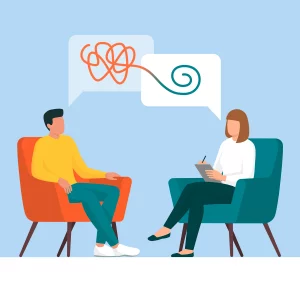
ISTDP
What does the efficacy research say about psychotherapy?
Basically, we know that approximately 50% of everyone who comes to therapy get a good effect from the therapy (Lambert, 2013). Considering that the field of therapy has been scientifically studied for just over 100 years, this is not so bad. We also know that 5-10% of everyone who goes to therapy gets worse, while 3-6% of those on the waiting list get worse (Lambert, 2013). So there is something unique about therapy that can actually hurt. Psychologists are ethically and professionally obliged to work to be able to help even more people. This is where the newest therapy methods come in, which try to be able to answer the questions that all psychologists ask themselves from time to time:
"Why is my patient getting worse?"
"Why is my patient not getting anything out of the therapy?"

What is intensive dynamic short-term therapy (ISTDP)?
ISTDP (Intensive Dynamic Short-Term Therapy) was developed in the 1960s by Dr. Habib Davanloo in Canada, and is still evolving. This form of therapy works with the patient's complaints through an advanced focus on feelings, thoughts and actions. One of the unique features of this therapy model is that it has methods for dealing with the two major challenges in the therapy room:
- The patient is made sick by his own feelings, memories, closeness or positive self-esteem
- The patient is blocked from own feelings, memories, closeness or positive self-esteem

The ISTDP principles for tailoring
In working with, among other things, trauma, depression, addiction and anxiety problems, it is common to have a combination of (a) not being able to stand oneself or life, (b) having lost contact with oneself or life, and (c) protecting against being with oneself or others. This is one of the things that makes this so difficult to treat.
In such situations, therapists can react by becoming frustrated, resigning or placing the blame on the patient. We have worked over several years on these topics, among other things through developing an environment at Psykologvirke with strong expertise in ISTDP, in addition to the fact that therapists from other therapy models have found ways to include elements of ISTDP in their treatments.
What does the research say about ISTDP?
ISTDP has been thoroughly researched both in Norway and internationally, and has a robust research base. Studies show that ISTDP can have a good effect on depression (Town, Abbass et al., 2017, 2020), anxiety (Lilliengren et al, 2017), PTSD (Roggenkamp et al, 2020), eating disorder (Nowowieski et al, 2020), pain conditions (Chavooshi et al, 2016), substance abuse problems (Frederickson et al, 2018) and personality disorder (Winston et al., 1994). In addition, good effects have been found in patients who previously had no effect from therapy, including in Norway (Solbakken & Abbass, 2014, 2015, 2016).

References:
Chavooshi, B., Mohammadkhani, P., & Dolatshahee, B. (2016). Efficacy of Intensive Short-Term Dynamic Psychotherapy for Medically Unexplained Pain: A Pilot Three-Armed Randomized Controlled Trial Comparison with Mindfulness-Based Stress Reduction. Psychotherapy and Psychosomatics, 123–125.
Frederickson, J., DenDooven, B., Abbass, A., Solbakken, OA, & Rousmaniere, T. (2018). Pilot study: An inpatient drug rehabilitation program based on intensive short-term dynamic psychotherapy. Journal of Addictive Diseases, 37(3-4), 195-201
Lambert, M. J. (2013). Outcome in psychotherapy: The past and important advances. Psychotherapy, 50(1), 42–51.
Lilliengren P, Johansson R, Town JM, Kisely S, Abbass A (2017). Intensive Short-Term Dynamic Psychotherapy for generalized anxiety disorder: A pilot effectiveness and process-outcome study. Clinical Psychology & Psychotherapy.
Nowoweiski D, Abbass A, Town J, Keshen A, Kisely S (2020). An observational study of the treatment and cost effectiveness of intensive short-term dynamic psychotherapy on a cohort of eating disorder patients. Journal of Psychiatry and Behavioral Sciences , 3(1), 1030.
Roggenkamp H, Abbass A, Kisely S, Town J, Johansson R (2020). Healthcare cost reduction and psychiatric symptom improvement in posttraumatic stress disorder patients treated with intensive short-term dynamic psychotherapy. European Journal of Trauma and Dissociation
Solbakken, OA, & Abbass, A. (2014). Implementation of an intensive short-term dynamic treatment program for patients with treatment-resistant disorders in residential care. BMC Psychiatry, 14, 12.
Solbakken, OA, & Abbass, A. (2015). Intensive short-term dynamic residential treatment program for patients with treatment-resistant disorders. Journal of Affective Disorders, 181, 67-77.
Solbakken, OA, & Abbass, A. (2016). Symptom and personality disorder changes in intensive short-term dynamic residential treatment for treatment-resistant anxiety and depressive disorders. Acta Neuropsychiatrica. Advance online publication.
Town JM, Abbass A, Stride C, Bernier D (2017). A randomized controlled trial of Intensive Short-Term Dynamic Psychotherapy for treatment resistant depression: the Halifax Depression Study. Journal of Affective Disorders, 214, 15-25.
Town, JM, Abbass, A., Stride, C., Nunes, A., Bernier, D., & Berrigan, P. (2020). Efficacy and cost-effectiveness of intensive short-term dynamic psychotherapy for treatment-resistant depression: 18-month follow-up of the Halifax depression trial. Journal of Affective Disorders, 273, 194-202.








